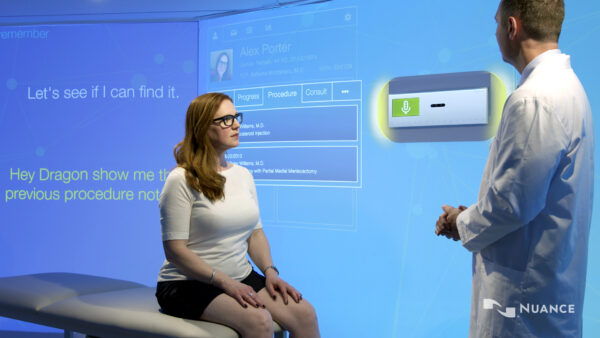
Nuance’s Ambient Clinical Intelligence technology automates clinical documentation (The picture is not an actual exam room)
Enough has been said about the lack of patient-centricity of the exam room where the doctor sits ensconced next to the computer, dutifully taking notes, as the patient rattles off a list of maladies.
Physically and emotionally, the exam room is cold with little eye contact between patient and doctor. Ironically, one technology company is relying on machines and artificial intelligence to bring back the warmth to the doctor-patient interaction in the exam room and catapult clinical documentation to the future.
Burlington, Massachusetts-based Nuance has developed Ambient Clinical Intelligence technology that aims to free physicians from the burden of clinical documentation, which often contributes to physician burnout. The ACI technology, which the public company revealed earlier this year during the annual HIMSS conference in February, also seeks to improve the patient experience. In addition to targeting healthcare, Nuance’s conversational and cognitive artificial intelligence products are sold in the automotive, telecommunications, financial services and government sectors.
ACI builds on Nuance’s existing Dragon Medical One cloud platform, which integrates with the EHR and leverages conversational AI for clinical documentation purposes. With the DMO desktop app, providers can speak naturally to capture information during a patient encounter, and the information is available in the patient’s record. Clinicians can also pair the Dragon Medical One offering with PowerMic Mobile, an app for iPhone or Android that lets them use their own smartphone to document patient information.
Ambient Clinical Intelligence takes it further.
Instead of solely focusing on clinician dictation like Dragon, ACI brings AI into the whole exam room to promote natural language interaction. The actual hardware is affixed to the wall of the room and has 16 microphones. It can capture what the patient and provider say, and relevant patient responses are added to the note, thereby eliminating the need for the doctor to reenter it later into the EHR.
With ACI, the doctor isn’t required to have a desktop computer in the room. The conversation from the encounter is automatically entered as a clinical note and the documentation can be displayed on a desktop, iPad, mobile app or TV monitor in the room.
Here’s how a demo video describes the new patient-doc interaction: The patient is a woman who has been having pain in her right knee. The doctor is standing in front of her directly facing her.
Doc: What can I do for you today?
Patient: It’s my right knee. For about the last two months, it’s been really hurting any time that I sit down or stand up.
Doc: Now didn’t we give an injection in your left knee a while ago?
Patient: Yes, but I don’t remember when that was.
Doc: Let’s see if I can find it. (Addressing Nuance’s AI tool) Hey Dragon, show me the previous procedure notes. [Similar to the way consumers may say “Hey Siri”]
The Dragon virtual assistant pulls up lists of previous procedures.
At one point the doctor asks, “And where does your right knee hurt?” While gesturing to the inside of her right knee, the patient responds, “It’s right here.”
Nuance has plans to advance the ACI tool to the point where machine vision technology can help understand and resolve non-verbal cues like this and automatically gather telemetry data such as body measurements for the provider, said Kenneth Harper, Nuance’s vice president and general manager of healthcare virtual assistants, in an email. The technology handles different accents and dialects due to all the data Nuance has used to train its speech AI, he added.
ACI also uses voice biometrics for authentication, speaker identification, patient consent and physician document signing. Additionally, ACI automatically extracts problems so the doctor can verbally accept them. The doctor can complete medication orders and sign the note using the Dragon virtual assistant.
In other words, all the paperwork and mundane but necessary minutiae have been outsourced to technology and all of that information is captured in the EHR.
As far as privacy, patients have to consent to the doctor using the ACI technology, said Peter Durlach, senior vice president of strategy and new business development for Nuance’s healthcare division, in a recent phone interview. For patients who are uncomfortable, the recording can be turned off.
Nuance has not set the final pricing for ACI.
It goes without saying that affordability will be key to getting the tech adopted widely. Another company has also reimagined the patient-doctor interaction, although its vision is less about clinical documentation. Forward, a San Francisco-based company, lets patients get a consultation with a doctor, a 3D body scan, lab results and a genetics kit. But it has focused on the consumer and has a steep $149 per month membership fee.
Nuance, by contrast, has been working with providers to bring advanced tech into the clinical workflow. The company has a partnership with Partners HealthCare through which the two organizations are utilizing AI to improve radiologists’ efficiency.
The company plans to commercially roll out ACI in 2020. Three organizations are currently piloting ACI, though the company will likely have between five and eight entities in pilot mode before the official launch, according to Durlach.
One of those pilot sites is EmergeOrtho, a physician-owned orthopedic practice headquartered in Durham, North Carolina. It formed when four ortho practices merged in 2016 and now includes 49 offices in 21 counties across the state. EmergeOrtho is using an early version of ACI.
Dr. Thomas Dimmig, an orthopedic surgeon and president of the company, said his organization is using Nuance’s ACI in one of its offices in the Research Triangle Park area of North Carolina. Not all exam rooms in that office are equipped with the technology, but the goal is to deploy more going forward, he explained in a phone interview.
He said the journey to clinical documentation began years ago, when Jared Pelo, the founder of medical documentation startup iScribes, reached out to groups in the Research Triangle asking if anyone would be interested in a new form of remote digital scribing. iScribes equips doctors with a mobile app, and trained virtual medical scribes complete the documentation work.
At that time, Dimmig was president of Triangle Orthopaedic Associates, one of the groups that merged into EmergeOrtho. Dimmig responded to Pelo’s email and his organization began using iScribes.
“It was a solution to our nightmare of clinical documentation in a smart, disruptive way,” Dimmig recalled.
Nuance later acquired iScribes. Now, EmergeOrtho has been working with Nuance on the ACI project for about the last six to eight months. While the ROI on this type of technology is complicated, it’s useful for improving efficiency, Dimmig said.
“The beauty of it is when I walk out of the room, I’m done,” he declared.
In other words, it’s hard to put a price on mental peace like this. Dimmig declined to disclose EmergeOrtho’s financial relationship with Nuance.
Nuance isn’t the only company addressing clinical documentation. A startup called Notable offers a wearable app for doctors that records the patient encounter and enters information into the EHR. Another new company, Suki, leverages AI to power a voice assistant that helps doctors with documentation. The tool also integrates with the EHR.
However, what differentiates Nuance from such startups is that it has massive amounts of data to build accurate models on which the AI can be trained, Durlach declared. The company commits $300 million annually to healthcare R&D.
There are also larger cloud companies competing in the space, such as Microsoft that has developed an AI chatbot platform and an AI-powered scribe service. While these companies have money, they may not have the relationships Nuance has cultivated with EHR vendors, Durlach noted.
Overall, the goal of ACI is to enable doctors to focus on their patients rather than the clinical note or technology.
“Our primary mission in our healthcare division is to build technology that allows clinicians to get back to taking care of patients,” Durlach said.
And one element of that could be better eye contact between doctor and patients, which can boost patient satisfaction.
Recent studies have found a “clinician’s eye contact (gaze) with patients is a significant predictor for perceived patient-centered communication and satisfaction, while establishing eye contact between the clinician and patient is linked to perceptions of higher levels of clinician communication, empathy, attention and warmth,” wrote Ellen Taylor, vice president for research at The Center for Health Design, in an email.
Photo: Nuance










